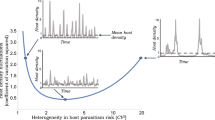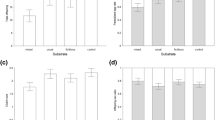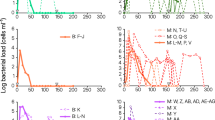Abstract
STUDIES of insect host–parasitoid interactions have contributed much to the consensus that spatial patchiness is important in the regulation of natural populations1–5. A variety of theoretical models predict that host and parasitoid populations, although unstable in the absence of environmental heterogeneity, may persist at roughly steady overall densities in a patchy environment owing to variation in levels of parasitism from patch to patch. Observed patterns of parasitism, however, have a variety of forms (with variation in attack rates among patches depending directly or indirectly on host density, or showing variation uncorrelated with host density). There is some confusion about the dynamical consequences of these different forms6,7. Here we first show how the dynamical effects of all these forms of environmental heterogeneity can be assessed by a common criterion. This 'CV2 > 1 rule' states that the overall population densities will remain roughly steady from generation to generation if the coefficient of variation squared (CV2) of the density of searching parasitoids in the vicinity of each host exceeds approximately unity. By partitioning CV2 into components, we show that both direct and inverse patterns of dependence on host density, and density-independent patterns, all contribute to population regulation in the same way. Second, we show how a maximum-likelihood method can be applied to the kind of field data that are usually available (that is, percentage parasitism versus local host density) to estimate the components of CV2. This analysis indicates that heterogeneity is large enough to stabilize dynamics in 9 of 34 published studies, and that density-independent heterogeneity is the main factor in most cases.
This is a preview of subscription content, access via your institution
Access options
Subscribe to this journal
Receive 51 print issues and online access
$199.00 per year
only $3.90 per issue
Buy this article
- Purchase on SpringerLink
- Instant access to full article PDF
Prices may be subject to local taxes which are calculated during checkout
Similar content being viewed by others
References
Hassell, M. P. & May, R. M. J. Anim. Ecol. 43, 567–594 (1974).
Hassell, M. P. & May, R. M. Ann. zool. Fenn. 25, 55–61 (1988).
Chesson, P. L. & Murdoch, W. W. Am. Nat. 127, 696–715 (1986).
Reeve, J. D. Am. Nat. 132, 810–836 (1988).
Taylor, A. D. Am. Nat. 132, 417–436 (1988).
Ehler, L. E. Environ. Ent. 15, 1268–1271 (1986).
Hassell, M. P. Ecol. Ent. 7, 365–377 (1982).
Lessells, C. M. J. Anim. Ecol. 54, 27–41 (1985).
Stiling, P. D. Ecology 68, 844–856 (1987).
Walde, S. J. & Murdoch, W. W. A. Rev. Ent. 33, 441–466 (1988).
Hassell, M. P. IMA J. appl. med. Biol. 1, 33 (1984).
Hassell, M. P. The Dynamics of Arthropod Predator-Prey Systems (Princeton University Press, 1978).
Hassell, M. P., May, R. M., Pacala, S. & Chesson, P. Am. Nat. (in the press).
Waage, J. K. Ecol. Ent. 8, 447–453 (1983).
Smith, A. D. M. & Maelzer, D. A. Ecol. Ent. 11, 425–434 (1986).
Casas, J. Physiol. Ent. 13, 373–380 (1988).
Casas, J. Ecol. Ent. 14, (1989).
Griffiths, K. J. Can. Ent. 101, 673–713 (1969).
Griffiths, K. J. & Holling, C. S. Can. Ent. 101, 785–818 (1969).
May, R. M. J. Anim. Ecol. 47, 833–843 (1978).
Hassell, M. P. & May, R. M. J. Anim. Ecol. 42, 693–726 (1973).
Pacala, S. & Hassell, M. P. Am. Nat. (in the press).
Brown, M. W. & Cameron, E. A. Environ. Ent. 8, 77–80 (1979).
Hassell, M. P., Lessells, C. M. & McGavin, G. C. Ecol. Ent. 10, 393–402 (1985).
Ehler, L. E. Environ. Ent. 15, 1268–1271 (1986).
Elliott, J. M. J. Anim. Ecol. 52, 315–330 (1983).
Freeman, B. E. & Parnell, J. R. J. Anim. Ecol. 42, 779–784 (1983).
Heads, P. A. & Lawton, J. H. Oikos 40, 267–276 (1983).
Jones, T. H. & Hassell, M. P. Ecol. Ent. 13, 309–317 (1988).
Hirose, Y., Kimoto, H. & Hiemata, K. Appl. Ent. Zool. 11, 116–125 (1976).
McClure, M. S. Environ. Ent. 6, 551–555 (1977).
Munster-Svendsen, M. Ecol. Ent. 5, 373–383 (1980).
Murdoch, W. W., Reeve, J. D., Huffaker, C. E. & Kennett, C. E. Am. Nat. 123, 92 (1984).
Smith, A. D. M. & Maelzer, D. A. Ecol. Ent. 11, 425–434 (1986).
Stiling, P. D. J. Anim. Ecol. 43, 793–805 (1980).
Strassman, J. E. Ecology 62, 1225–1233 (1981).
Thorarinsson, K. Ecology (in the press).
Trexler, J. C. Oikos 44, 415–422 (1985).
Weseloh, R. M. Ann. ent. Soc. Am. 65, 64–69 (1972).
Author information
Authors and Affiliations
Rights and permissions
About this article
Cite this article
Pacala, S., Hassell, M. & May, R. Host–parasitoid associations in patchy environments. Nature 344, 150–153 (1990). https://doi.org/10.1038/344150a0
Received:
Accepted:
Issue date:
DOI: https://doi.org/10.1038/344150a0
This article is cited by
-
Infestation dynamics between parasitic Antarctic fish leeches (Piscicolidae) and their crocodile icefish hosts (Channichthyidae)
Polar Biology (2020)
-
Using artificial systems to explore the ecology and evolution of symbioses
Cellular and Molecular Life Sciences (2011)
-
Evolutionary ecology of movement by predators and prey
Theoretical Ecology (2011)
-
Stabilization effects of spatial aggregation of vectors in plant disease systems
Population Ecology (1998)
-
Adaptive superparasitism and host-parasitoid dynamics
Bulletin of Mathematical Biology (1997)



